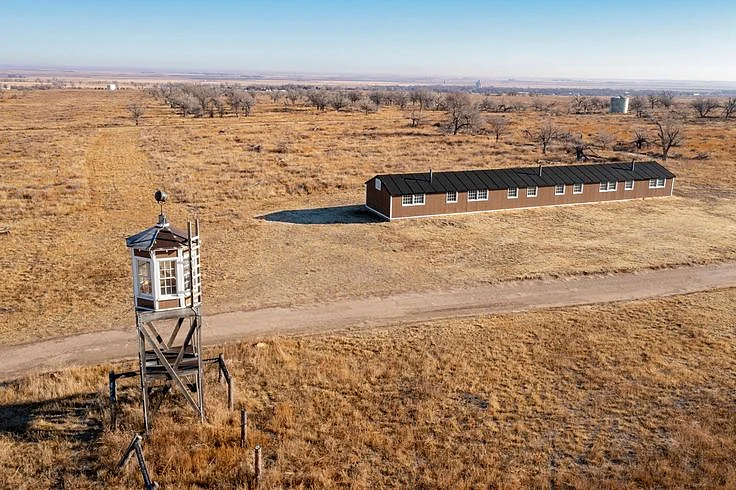A solitary wind whispers across the barren plains of southeastern Colorado, carrying echoes of a troubled past. Here, nestled amidst the dry shortgrass and sagebrush, stands Amache National Historic Site, the newest addition to the US National Park System. Unlike the majestic mountains or sprawling canyons that typically define national parks, Amache offers a stark and haunting look at a bygone era – a World War II incarceration camp that housed over 10,000 Japanese Americans.
Amache National Historic Site: A Former WWII Incarceration Camp Now A National Park
Amache National Historic Site in southeastern Colorado is a stark reminder of a World War II incarceration camp that housed over 10,000 Japanese Americans. Following the 1941 attack on Pearl Harbor, President Franklin D. Roosevelt authorized the removal of over 120,000 Japanese Americans, two-thirds of whom were US citizens.

From Pearl Harbor to incarceration
Following the attack on Pearl Harbor in 1941, a wave of anti-Japanese sentiment swept across the nation, fueled by fear and suspicion. Executive Order 9066, signed by President Franklin D. Roosevelt in 1942, authorized the forcible removal of all persons deemed a threat to national security from the West Coast. This order, rooted in prejudice rather than any genuine threat, disproportionately impacted Japanese Americans, two-thirds of whom were US citizens. Given mere days or weeks' notice, over 120,000 men, women, and children were uprooted from their homes and communities, sent to hastily constructed incarceration centers scattered across the Western United States.
Life behind barbed wire
Amache, established in 1942, quickly ballooned into a small, densely populated city. At its peak, over 7,500 Japanese Americans were confined within its one-square-mile perimeter, making it more crowded than New York City at the time. Barbed wire fences and armed guards served as a constant reminder of their captivity, yet within these harsh confines, an extraordinary story of resilience unfolded.
Resilience in the face of adversity
The internees, as they were called, set about creating a semblance of normalcy within the confines of the camp. Organized like a military base, Amache consisted of residential blocks with barracks, mess halls, and recreation facilities. Schools were established, social activities organized, and even gardens cultivated. An intricate network of community life emerged, with families sharing cramped quarters, children attending classes, and young adults participating in sports leagues and cultural events. Despite the constant threat and uncertainty hanging over them, the Amache community persevered, their spirit unbroken.

Archaeological discoveries shed light on daily life
The legacy of Amache extends far beyond its barbed wire fences. The incarceration of Japanese Americans during World War II was a shameful chapter in American history, a stark reminder of the dangers of unchecked prejudice and the fragility of civil liberties. Archaeological research at the site continues to unearth a wealth of information about the daily lives of the internees, offering a deeper understanding of their experiences. Artifacts like gardening tools and remnants of sports fields speak volumes about their efforts to maintain a sense of normalcy. The Amache story resonates deeply, serving as a cautionary tale for future generations.
Amache National Historic Site today
Today, Amache National Historic Site stands as a testament to both the enduring human spirit and the injustices of the past. Visitors can embark on self-guided tours, exploring the reconstructed barracks, the poignant cemetery, and the Amache Museum located nearby. Here, historical photographs, documents, and artifacts offer a glimpse into the lives of those who were incarcerated.
The National Park Service is actively developing educational programs and a visitor center to further enhance understanding and provide a more comprehensive picture of Amache's history. The designation of Amache as a national park ensures that this dark chapter will not be forgotten, its stories serving as a powerful reminder of the importance of tolerance and the enduring strength of the human spirit in the face of adversity.
The forced removal and incarceration of Japanese Americans during World War II had a profound and lasting impact. Families were fractured, with many children separated from their parents. The experience of living behind barbed wire, deprived of their freedom and livelihoods, left deep emotional scars. This trauma was passed down through generations, creating a silence and a sense of dislocation within Japanese American communities.
The story of Amache serves as a powerful reminder of the dangers of prejudice and the importance of safeguarding civil liberties. It compels us to examine historical injustices and ensure such actions are never repeated. By learning about the experiences of those incarcerated at Amache, we can cultivate empathy and understanding, fostering a more inclusive and tolerant society.
Planning to visit Amache?
Amache National Historic Site is currently undergoing development as a fully-fledged national park. Visitors can embark on self-guided tours, following a designated route that winds past reconstructed barracks, the monument house, and the poignant cemetery.
The Amache Museum, located approximately 1.5 miles from the site, offers a wealth of historical information with exhibits, artifacts, and personal stories of the internees. The National Park Service is actively developing educational programs and a visitor center that will provide a more immersive and informative experience.
-
Previous Story
 Hurricane Milton Now At Category 5; Florida Evacuates And Braces For Landfall | What We Know
Hurricane Milton Now At Category 5; Florida Evacuates And Braces For Landfall | What We Know - Next Story





















